Delphi 2025 Crypto Market Outlook Highlights Summary

Reprinted from jinse
12/23/2024·5MAuthor: Stacy Muur, Web3 researcher; Translated by: Golden Finance xiaozou
I've been paying close attention to the research published by some of the brightest Web3 teams. Their articles provide food for thought, show different perspectives, and help you become more convinced of the views you agree with.
Research articles contain professional opinions that can help you better understand how different people view the Web3 field. Now let’s take a look at the Delphi team’s “2025 Crypto Market Outlook” summary.
1. Long live Bitcoin
Not long ago, many people thought a $100,000 Bitcoin was just a pipe dream.
Now, that sentiment has changed dramatically. Bitcoin’s market capitalization is approximately $2 trillion, which is truly staggering. If Bitcoin were a public company, it would be the sixth most valuable company in the world .
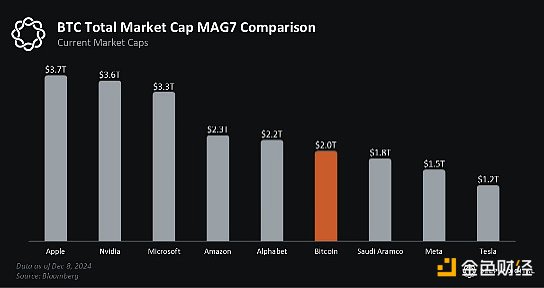
Bitcoin has attracted a lot of attention, but there is still considerable room for growth.
-
The market value of Bitcoin is only 11% of the total market value of the seven US technology giants (Apple, NVIDIA, Microsoft, Amazon, Google, META, and Tesla).
-
It is less than 3% of the total market capitalization of U.S. stocks and about 1.5% of the total market capitalization of global stocks.
-
Its entire market capitalization accounts for only 5% of the total outstanding public debt of the United States and less than 0.7% of the total global debt (public debt + private debt).
-
The size of U.S. money market funds is three times the market capitalization of Bitcoin.
-
The market value of Bitcoin only accounts for about 15% of the total global foreign exchange reserve assets. Hypothetically, if global central banks reallocated 5% of their respective gold reserves to Bitcoin, it would add more than $150 billion in purchasing power—three times the total net inflows into IBIT this year.
-
Household net worth has reached an all-time high of over $160 trillion, more than $40 trillion higher than its pre-pandemic peak. This growth, largely driven by rising housing prices and a booming stock market, is 80 times greater than Bitcoin’s current market capitalization.
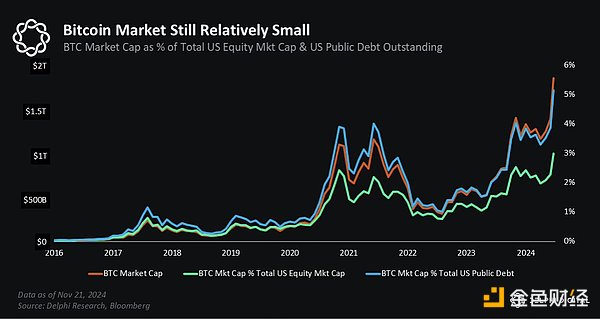
In a world where the Federal Reserve and other central banks cause their currencies to depreciate by 5-7% per year, investors need to aim for annual returns of 10-15% to make up for the resulting loss of purchasing power in the future.
So you get the idea:
-
At a depreciation rate of 5% per year, the real value of the currency will fall by half in 14 years .
-
At a depreciation rate of 7% per year, the real value of the currency will fall by half in 10 years .
This is why Bitcoin and other high-growth industries are gaining so much attention and traction.
2. Altcoin disillusionment
While Bitcoin has hit all-time highs again and again this year, 2024 is not going to be such a successful year for most altcoins.
-
ETH has not reached all-time highs.
-
SOL has hit an all-time high again, but it's only a few dollars above its previous high, which is a bit insignificant compared to the growth in market cap and network activity.
-
ARB started the year strong but started to underperform towards the end of the year.
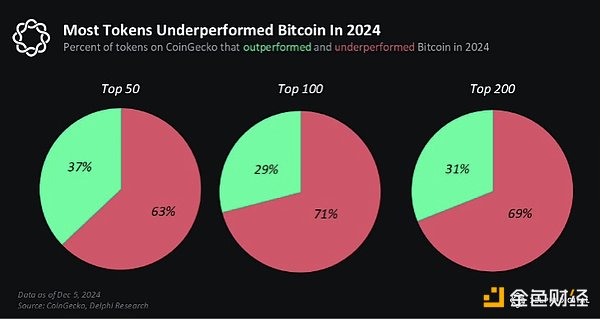
There are many such examples. Just look at the data for 90% of the altcoins in your portfolio and it will become clear.
What is the specific reason?
The first reason is Bitcoin’s dominance . Bitcoin has had a remarkable year, fueled by ETF flows and Trump support, leading to a more than 130% year- to-date price increase and boosting its dominance to a three-year high.
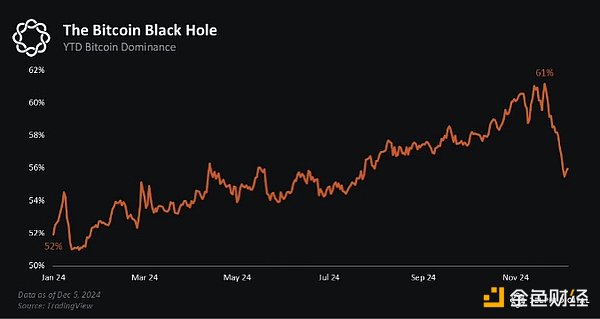
The second reason is that the market is fragmented.
Market fragmentation this year is a new phenomenon in the crypto market. Previous market cycles tended to favor synchronized trading. When BTC goes up 1%, ETH usually goes up 2% and altcoins go up 3%, with predictable patterns. However, this cycle is different.
There are a small number of cryptocurrencies that are doing extremely well, but there are also large swaths of red.
The rising Bitcoin wave did not benefit everyone, and the classic “Path to Altseason” that many expected did not materialize.
Last but not least, Meme coins (and more recently AI Agents).
Cryptocurrencies have always vacillated between “pure Ponzi schemes” and “technologies that promise to change the world.” In 2024, the former dominates the discourse.
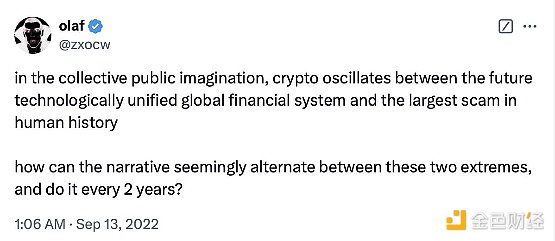
The meme coin super cycle has amplified the notion that cryptocurrencies are just one giant Ponzi scheme. People are starting to question whether fundamentals really matter and whether cryptocurrencies are just “casinos on Mars” — and these concerns are legitimate.
In this regard, I would like to say a little more.
When Memecoins are labeled as the top performers of the year, only the largest Memecoins are taken into account – those that have created significant market capitalization and built communities. People often ignore the fact that 95% of Meme coins issued fail to maintain their value, but people are "willing to believe".
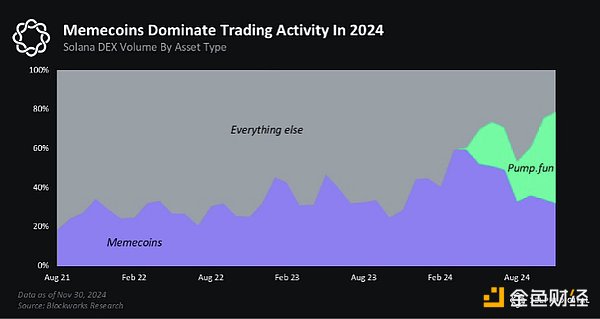
With this belief in mind, many people who had previously invested in altcoins switched to Meme coins—some succeeded, but most failed. As a result, capital inflows are mainly distributed between Bitcoin (institutional capital) and meme coins (high risk), squeezing most altcoins aside.
Delphi believes that 2025 will usher in a transition to "world-changing" technology .
Personally, I'm not too optimistic. In 2024, there will be many KOLs who mainly focus on Meme coins. For example, if I create a Telegram folder with some really valuable channels, it would be very difficult to find a channel that is not centered around "ape calls". This is the attention game, and widely discussed narratives can heavily influence market trends.
3. What’s next?
(1) Stablecoin growth and credit expansion
A major obstacle facing the market is the oversupply of tokens. The market is facing a flood of new assets from private equity investments and public token offerings. For example, more than 4 million tokens will be issued on Solana’s pump.fun in 2024 alone. Meanwhile, the total cryptocurrency market capitalization has only grown 3x since the last cycle, compared with 18x growth in 2017 and 10x growth in 2020.
The missing elements—stablecoin growth and credit expansion—are starting to reappear. Lower interest rates and friendlier regulations are expected to stimulate speculation and address these imbalances. As stablecoins regain traction, their trading and collateral-based role will be critical to market recovery.
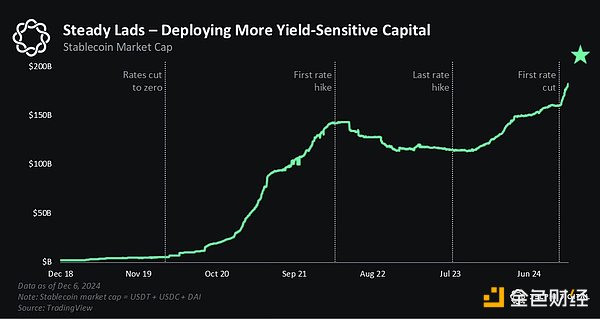
(2) Institutional capital inflow
Until last year, institutional capital was very hesitant to participate in cryptocurrencies due to regulatory uncertainty. However, this is starting to change with the SEC reluctantly approving a spot Bitcoin ETF, paving the way for future institutional investment.
These institutional investors look for investment opportunities that they are familiar with. While some investors may dabble in Meme coins, they are more likely to be more interested in assets in areas such as ETH/SOL, DeFi or infrastructure.
Delphi predicts that the coming year will be similar to the " across the board " phenomenon of previous cycles. This time, projects based on fundamental principles or core goals will gain renewed focus. These may include assets such as OG DeFi, which have good historical performance and are battle-tested. They may also be infrastructure assets, similar to the L1 transactions we observed previously. Others may include RWAs (real world assets) or emerging areas such as artificial intelligence or DePIN.
Not every cryptocurrency is going to see triple-digit gains like before, and meme coins are here to stay. This could mark a new beginning and a broad crypto rally.
Note: Generally speaking, most institutional traders rely heavily on options hedging. Therefore, if there is a "broad rally", the assets most likely to attract investor interest will be those with options, primarily tradeable on Deribit or Aevo.
(3) Solana dominance
Solana demonstrates the resilience of the blockchain ecosystem. After suffering a 96% plunge during the FTX crash, Solana staged a stunning rebound in 2024.
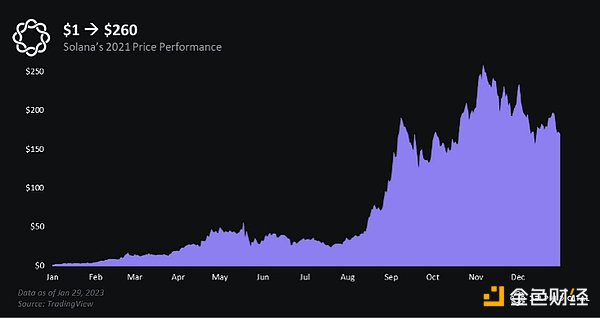
Key highlights include:
-
Developer Momentum: Solana’s hackathons and airdrops (like the Jito Airdrop) reignite developer and user engagement, creating a virtuous cycle of innovation and adoption.
-
Market dominance: From meme coins to artificial intelligence applications, Solana dominates the trends of 2024. Notably, its real economic value (REV)—a measure of transaction fees and MEV—exceeds Ethereum’s by more than 200%.
-
Future Outlook: Solana is expected to challenge Ethereum’s dominance in terms of scaling and user experience. Its seamless user experience and centralized ecosystem provide significant advantages over decentralized L2 solutions.
4. Final Thoughts
For many, the current market situation may be reminiscent of 2017-2018, when Bitcoin peaked at $20,000 before the new year and began to decline shortly after the arrival of 2018. However, in my opinion, comparing the crypto market in 2018 to the market in 2025 is irrelevant. These are two completely different environments.
It’s important to realize that the broader crypto market extends far beyond CT and X’s timeline. People outside these platforms view the market very differently.
In 2025, I expect the crypto market to be divided into two main verticals:
-
Web3 Natives: Refers to traders who are deeply rooted in the crypto market. They have a nuanced understanding of Bitcoin’s unique characteristics and a willingness to engage in high-risk transactions, including meme coins, AI agents, and pre-sales—elements reminiscent of the Wild West.
-
Regular Investors: Institutional investors and retail investors tend to have different approaches to risk management, and they typically stick to more basic investing and trading strategies – viewing cryptocurrencies as an alternative to the stock market.
Which verticals will be marginalized? It is those DeFi, RWA and DePIN protocols in the early stages that cannot ensure that they stay ahead in the market segment or at least on the chain. This is just my idea.


 chaincatcher
chaincatcher
 panewslab
panewslab